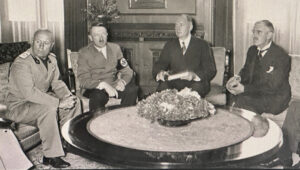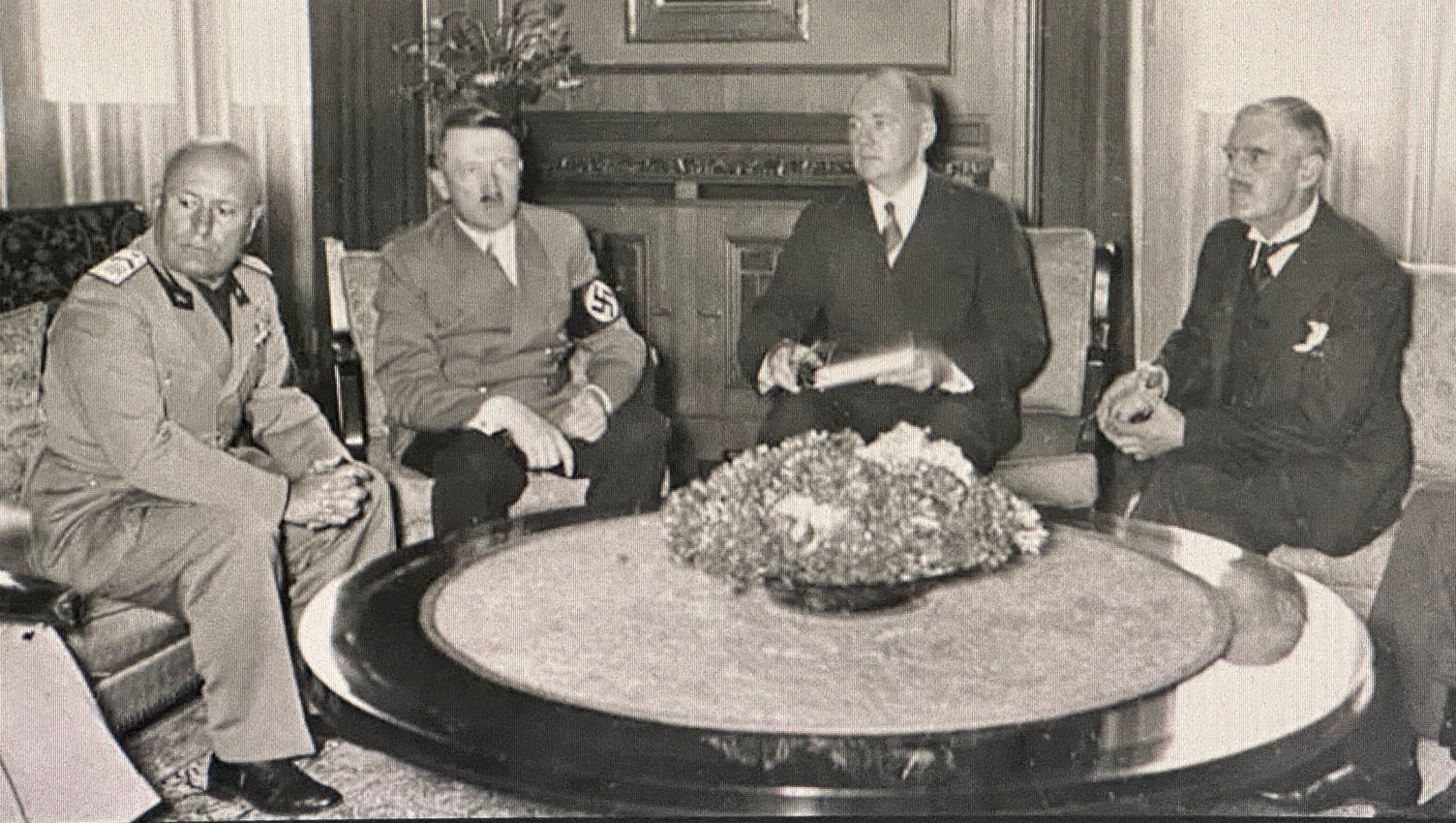While Neville Chamberlain is most famous for being Prime Minister, and appeasing Hitler, this book makes it clear he was first and foremost a birdwatcher.
Just two days before was forced to resign as PM, with World War II about to engulf all of Europe, his mind was not focused on the great issue at hand. “Remarkably, the letters show that on the morning of 8 May 1940, during the two-day debate in Parliament on the disastrous Norway campaign which led to his downfall, Chamberlain was busy looking for a kestrel nest in St. James’s Park.”
As that extract shows, even the author of this book on Chamberlain is incredulous. In his first book, Nicholas Milton, a military and natural historian, has given us what must be the most unusual prime ministerial biography ever written. With its fascinating insights into what Chamberlain was actually thinking and doing, it’s a real eye-opener.
Milton relies heavily in this book on letters Chamberlain wrote to his sisters Hilda and Ida; their correspondence is in Birmingham. And while the letters have already been published, Milton’s extracts from them are weaved into a chronicle of his work as Prime Minister. What we have, in effect, is a dual-track biography.
Before he became PM, Chamberlain was Chancellor, meaning he was in charge of the nation’s finances. On 21 April 1936, he brought his budget before the House. It included an income tax rise to pay for “the largest programme of rearmament in Britain’s peacetime history.” But this was secondary to his true interests. “What gave him most joy,” writes Milton, “was some bird news from the garden of 11 Downing Street.” On 2 May Chamberlain wrote excitedly to Hilda: “The cuckoo has arrived here.” Many of Chamberlain’s detractors would certainly have agreed, but they would not have been thinking of the bird.
July of that year was dominated by the start of the Spanish Civil War, but when Chamberlain wrote an article for The Daily Telegraph newspaper, it was not about this major conflict. Rather, he wrote about a mystery bird in the garden. That spring, he wrote, “the first sound that came through the open window of my bedroom in the morning was the song of a thrush. It was only after a long time that I began to remark to myself that never had I heard a thrush put so little variety into its song.” Maybe it wasn’t a thrush after all! Giving the solution to this mystery a high priority, he resolved to see the bird for himself. “It was a blackbird imitating the habit as well as the notes of the song thrush, and proud of its accomplishment,” Chamberlain wrote. During the 1936 Parliamentary recess, Chamberlain went to Scotland “where he walked, fished and watched birds.”
Milton gives us an example of how disconnected the PM was. Throughout October more than 200 men marched from Jarrow to London “in protest against the unemployment and poverty in the town following the closure of its main employers, Palmers shipyard. It was an event which seems largely to have passed Chamberlain by.” The marchers brought a request to Parliament for their case to be heard, and Chamberlain was obliged to attend the House. “Chamberlain was annoyed, not because he sympathized with the marchers, but because he planned to go to see the opera Figaro.” The case of the marchers was dismissed without a hearing.
At the height of the Abdication crisis in November 1936, he wrote to Hilda what really occupied his thoughts. After he had woken from sleep, he “heard a brown owl talking to himself in the garden here, and yesterday after lunch I am almost certain I saw the Kestrel fly across the sky.”
The following May he became PM, and during his time in that post Chamberlain kept up a lively correspondence with Gilbert Collett, a fellow birdwatcher. Collet would often write about an unusual bird he saw in St James’s Park, and the PM followed up (to the delight of the reader of this book, all the letters from Collet are printed here, along with the replies sent via the PM’s staff). This was hardly kept quiet from the public. The Times newspaper, for example, printed this report in late 1938 after Chamberlain had been alerted to a startling find by Collet:
“Last Friday morning the Prime Minister came to the breakfast table showing definite signs of excitement.” The reader of this likely expected some news about Germany, but no. “I have received information,” Chamberlain said, “that a Scaup has arrived in St. James’s Park. Don’t you think we ought to go out and find it?” Both Chamberlain and his wife left Number 10 and made a careful search, finally finding the Scaup on the pond. Of this episode Milton writes “After the excitement of seeing the scaup, the endless, thankless business of being Prime Minister in a mad world continued.”
Milton is equally adept at the ‘mad world’ stuff as he is on bird-brained material. This is a very fine exposition of the work Chamberlain did as PM, for which history has judged him very harshly. Milton is balanced in his analysis, but he does not shy away from damning comments when they are called for. On 15 September 1938 Chamberlain set off to meet Hitler for the first time. For each of his encounters with Hitler, Milton gives us a very intimate portrait of the entire scenario: the flights Chamberlain took and what he packed, the reception he got from the public in Germany and great detail as to where he stayed and the manner in which he met Hitler. Their conversations are related so that it feels like one was in the room with them. This alone is worth the price of the book, and is the best exposé of these crucial meetings I have read.
After that 1938 meeting, Chamberlain wrote to his sister Ida. “In spite of the hardness and ruthlessness I thought I saw in his [Hitler’s] face I got the impression that here was a man who could be relied upon when he had given his word.” Milton slashes at this: “It was to prove a fatal error in judgement.”
Meanwhile, he let Ida know a state secret that will likely astonish nearly every reader of this book. “He sensationally revealed,” writes the author, “that he had authorized the Special Branch to spy on Churchill.” His phone was bugged, and transcripts sent to Chamberlain. The bugged conversations, Chamberlain wrote to Ida, “shows how completely Winston can deceive himself when he wants to.”
By April of 1939, Chamberlain was confronted by Mussolini’s invasion of Corfu. He complained to Ida about having to interrupt his holiday to return to Parliament to face a growing chorus of opposition from Churchill and others. Milton writes ruefully about his stance at this crucial moment. “Stubborn as ever, Chamberlain refused to admit he had been mistaken,” in regarding Mussolini as a friend who could be manipulated to block Hitler. The invasion, Chamberlain declared, “does not show that I have been wrong as my partisan critics declare.” England, led by a man of execrable judgement, who was often pre-occupied by rare bird sightings, thus sleep-walked right into World War II. “Life is just one long nightmare,” he wrote to Ida after he finally declared war on Germany in 1939.
This excellent book starkly reveals Chamberlain missed his true vocation as an ornithologist. He was indeed the wrong man for the wrong job at the wrong time. Fortunately for the world, the right man for the right job at the right time replaced him within hours. Winston Churchill became Prime Minister on 10 May 1940.
Neville Chamberlain’s Legacy: Hitler, Munich and the Path to War lists for $49.95. It is by Pen & Sword Books.
Image (l to r): Mussolini, Hitler, an interpreter, Chamberlain; on 29 Sept. 1938. German Federal Archives (Bundesarchiv), Bild 146-1970-052-24Creative Commons Legal Code
Addendum: Churchill was not oblivious to the interests of wildlife. While Chamberlain just looked, however, Churchill was actually an early proponent of actually doing something to make things better. According to The Times in June 2023:
“The black-veined butterfly became extinct in the UK in 1925 after changes in land use following periods of wet and cold weather. As the UK weather is warmer than average this time of year, experts are hoping it will create conditions suited to the return of the butterfly, which Winston Churchill tried to bring back to life in the 1940s. Churchill imported caterpillars stuffed in muslin bags to Chartwell in Kent to breed the species, but his plans were accidentally thwarted by his gardener who cut the nests of the young caterpillars from the bushes where they had been carefully placed.”

